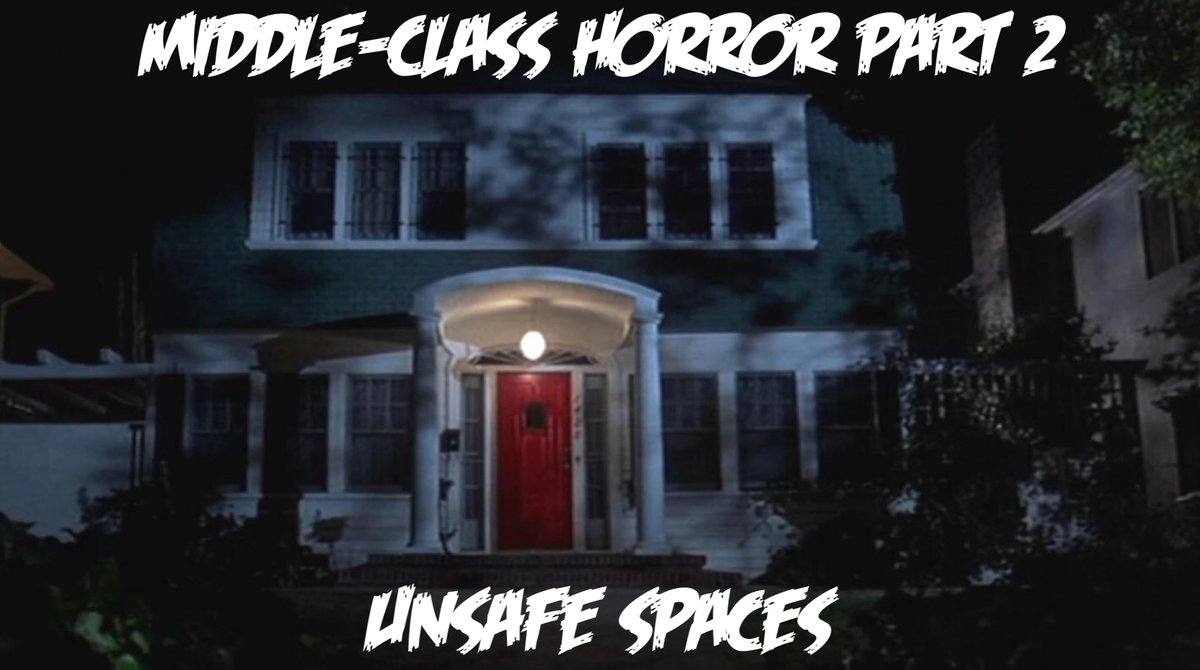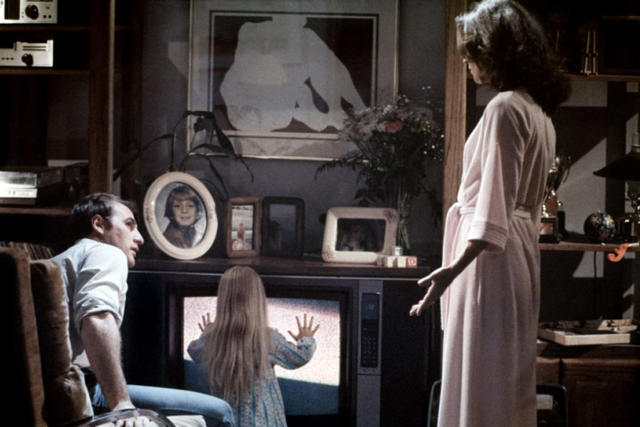Middle-Class Horror Part 2: Unsafe Spaces.
This is an ongoing series of threads, sponsored by my generous Patreon patron @nicaborders, where I discuss how Horror provides insight into Middle-Class fears and their roots in bigotry.
This is an ongoing series of threads, sponsored by my generous Patreon patron @nicaborders, where I discuss how Horror provides insight into Middle-Class fears and their roots in bigotry.
For more details please read the first thread:
https://twitter.com/fangirlJeanne/status/1250524191108902913
Disclaimer:">https://twitter.com/fangirlJe... I am not claiming authority on Horror or Sociology, just offering my perspective and seeking to entertain. Nor am I claiming insight into creators& #39; intent.
The author is dead™.
https://twitter.com/fangirlJeanne/status/1250524191108902913
Disclaimer:">https://twitter.com/fangirlJe... I am not claiming authority on Horror or Sociology, just offering my perspective and seeking to entertain. Nor am I claiming insight into creators& #39; intent.
The author is dead™.
Content Warning: Discussion of racism, stereotypes and mentions of child abuse, rape, and substance use.
To better understand Middle-Class fears we need to address bigotry behind what is considered “safe.” Specifically, how bigotry is at the root of why horror movie settings and the presence of violence in those settings are part of why they’re scary.
After WWII the quickly emerging Middle-Class became as much a geographic distinction as an economic class. Working class whites who enjoyed the modern conveniences of living in a city, wanted a place away from the poor whites, migrants, and Black people who were their neighbors.
While rural areas were removed from the city and dominated by whites they weren’t seen as aspirational by a generation who grew up during the Great Depression. To this day, stereotypes of rural America still evoke distinct imagery of poverty and squalor from that era.
The Suburbs were the best of both worlds. Removed from the migrants and people of color in urban areas with all the modern conveniences that marked the residences as more successful than the whites in rural areas (and bad memories of a less prosperous time in America).
Baby Boomers grew up in this sanitized racist utopia far removed from the inevitable toll their privilege took on everyone else. This came to shape their understanding of safety, prosperity, and goodness embodied by the ideal of the nuclear family. A man, his family, his home.
The idea of home as a place of safety and comfort isn’t new or unique to America, but it is at this time that the idea and iconography of Home takes on a racial and economic image that made it synonymous with white patriarchal power.
We see this reflected not only in the popular American media of the 50s and 60s, but also in how it’s challenged and repurposed in the media created by those who were raised during that era. In Spielberg’s use of masculine anxiety and reunification of heteronormative families.
Stephen King explores similar themes, while revisiting very white, masculine experiences of youth in the American 1950s and 60s. So, it shouldn’t be surprising that those distinctly Middle-Class white experiences are the settings of some of the most iconic horror movies.
For many of these influential media creators, violence and terror were things that happened outside of the home, brought into their living rooms by the television (via media coverage of the Vietnam War and Civil Rights movement). Violence happened to other people, in other places
The Suburbs, the family home, and even summer camps are supposed to be safe because they’re places of Middle-Class dominion and thus removed from spaces that are associated with violence, despite the reality that a great deal of violence was happening in those “safe spaces.”
For centuries women and children were considered to be the property of men. Rape began as a property crime. Something an outsider did to a man’s wife or child. Marital rape didn’t become illegal in all 50 States until 1993.
#NSFW CW: Boobs.
#NSFW CW: Boobs.
For many people during these influential eras, violence in the home wasn’t ever labelled as violence. It was “domestic disputes” or a “family matter.” This further defined violence as something that either happens or comes from outside the home. A threat to man’s home and family.
This centers patriarchal fears that seat a man’s masculinity in his ability to provide and protect, and as a result women and children are symbols of his strength and prosperity. Even when the violence isn’t happening to a man, his fears and anxieties are still prioritized.
While violence against women and children is horrifying, which is why many of these horror tropes work on all of us, their origins are rooted in these very white, patriarchal values. That influence still bleeds through and is replicated in horror media today.
Side Note: Marginalized people, many of whom are more likely to experience violence in real life, are just as likely to be seen as the perpetrators of violence, because they too are a threat to these white cis heteronormative ideals.
Defining a white middle-class home as a safe space not only implies that other spaces, like cities and rural areas are unsafe, but that the people who live in those spaces are likewise dangerous and a threat. It’s in the coded language we use to describe those spaces.
Cities are often characterized by racist stereotypes about Black people and migrants. “Urban Jungle, Savage streets. Dirty, violent, and uncivilized.” As I said before rural areas are characterized by imagery and stereotypes of poor whites dating back to the Great Depression.
This deeply rooted bigotry not only affects how we judge what spaces are safe or not, but it also causes us to misconstrue the relationship between proximity to violence and responsibility for that violence. In other words, who is more likely to be victimized and why.
We see this in the Black character dies first trope and the correlation between sex or substance use (drugs & alcohol) ending in death. Sex, drugs, and yes, even Black people are symbols of violence in the white Middle-Class subconscious. I’ll go into this more in Women in Peril.
The presumed safety extends to other places associated with white Middle-Class life. Summer camps, schools, vacation spots, etc. The root of this anxiety is white people’s sense of entitlement to feel safe in any space they occupy. See Gentrification.
The Suburbs are supposed to be a place where families are happy and whole. Where teens don’t have sex or use substances. Where there’s no violence and everyone (white) is safe. Thus the presumed safety of these spaces being violated is part of what makes the horror movie scary.
That’s it for Part 2 of Middle Class Horror: UnSafe Spaces. Stay tuned for more threads where I talk about ableism, classism, rape culture, and the destruction of the nuclear family in horror. I might be adding more threads too.
Upcoming threads:
The Predatory Poor: links between ableism and classism in horror.
Women in Peril: Fear of feminism and rape culture in horror.
What about the Children: Children as symbols of purity and the destruction of the nuclear family in horror.
The Predatory Poor: links between ableism and classism in horror.
Women in Peril: Fear of feminism and rape culture in horror.
What about the Children: Children as symbols of purity and the destruction of the nuclear family in horror.
Here& #39;s a list of the movies I& #39;m focusing on, if you’d like to (re)watch:
The Exorcist (1973)
Texas Chainsaw Massacre (1974)
Halloween (1978)
Friday the 13th (1980)
The Howling (1981)
Sleepaway Camp (1982)
Poltergeist (1982)
Nightmare on Elm Street (1984)
Hellraiser (1987)
The Exorcist (1973)
Texas Chainsaw Massacre (1974)
Halloween (1978)
Friday the 13th (1980)
The Howling (1981)
Sleepaway Camp (1982)
Poltergeist (1982)
Nightmare on Elm Street (1984)
Hellraiser (1987)
Again, thank you to @nicaborders for sponsoring this thread. If you like this or anything I do please consider supporting me via Ko-fi: https://ko-fi.com/A651JQJ ">https://ko-fi.com/A651JQJ&q...
Or become a patron: https://www.patreon.com/fangirljeanne ">https://www.patreon.com/fangirlje...
Or become a patron: https://www.patreon.com/fangirljeanne ">https://www.patreon.com/fangirlje...

 Read on Twitter
Read on Twitter








